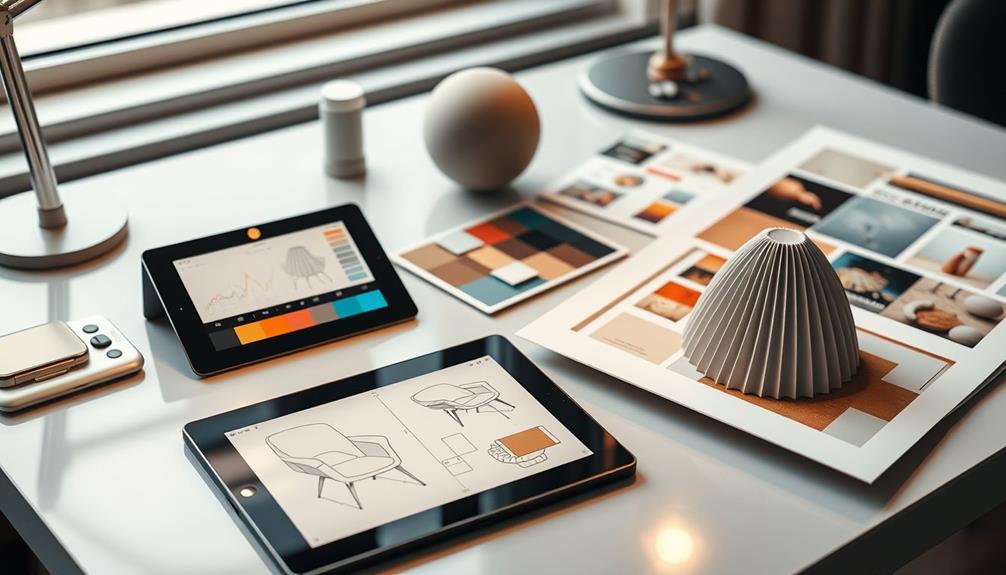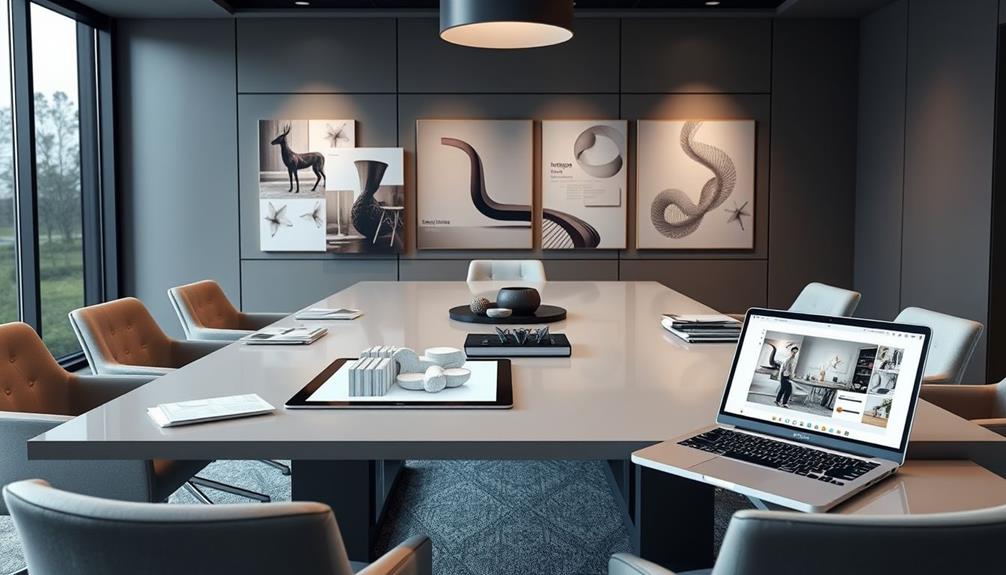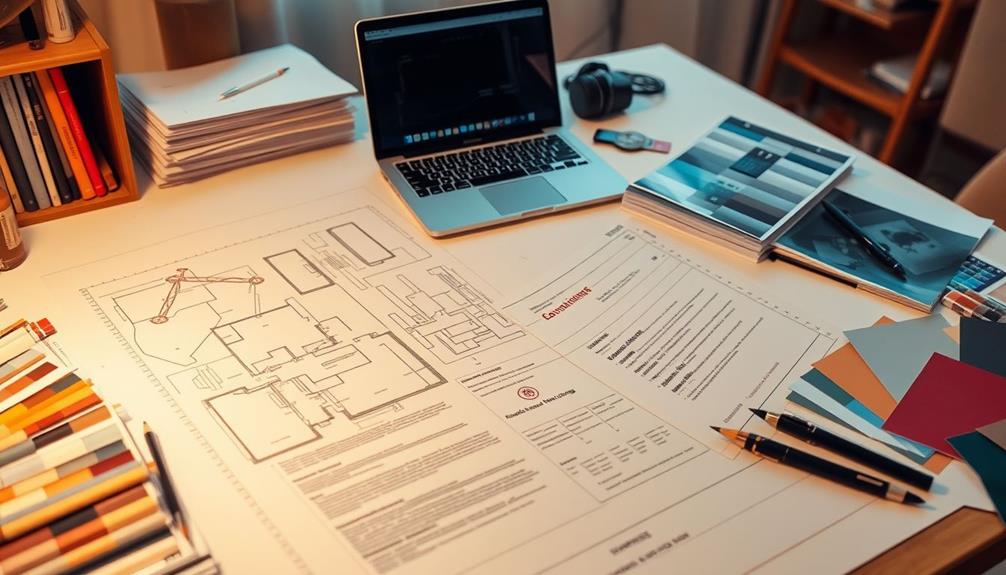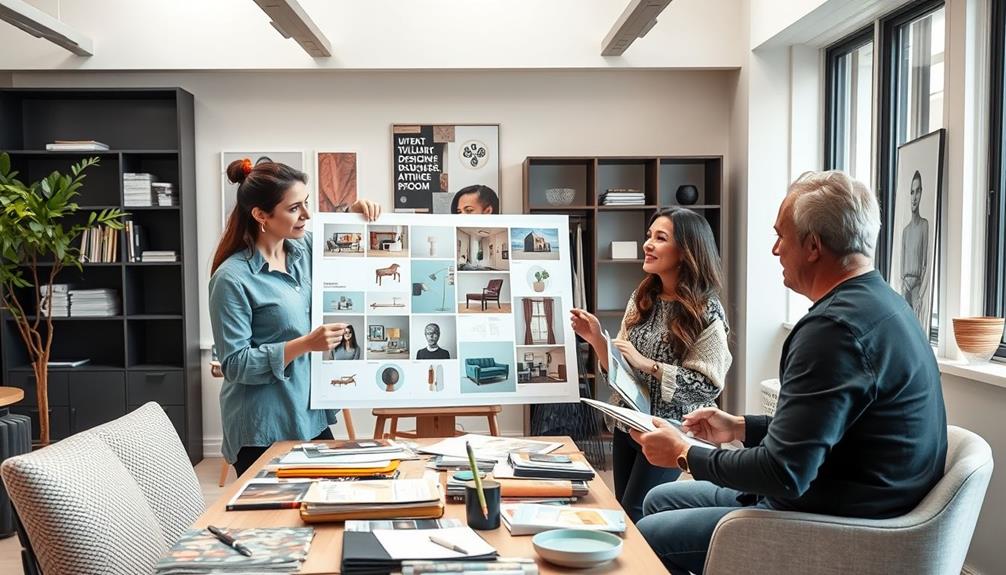To present interior design to your client effectively, start by using mood boards to convey your design vision. Combine high-quality images and material samples to create a tactile experience. Utilize digital tools for clarity and detailed floor plans to build trust. Schedule regular presentations, and encourage feedback to foster collaboration. Make your visuals engaging with 3D renderings for a better understanding of the space. Finally, guarantee you stay compliant with copyright laws to respect image usage. This approach not only enhances your client's experience but also aligns with their preferences. Discover further insights to refine your presentations.
Key Takeaways
- Create mood boards to visually communicate design concepts and evoke emotional responses from clients.
- Utilize digital tools for clear presentations, incorporating detailed floor plans and accurate dimensions to build trust.
- Engage clients through physical samples and immersive experiences, fostering a deeper connection to the design.
- Schedule presentations at key milestones, encouraging feedback and collaboration to refine design ideas.
- Practice active listening to understand client preferences, ensuring personalized interactions and transparent communication throughout the process.
Understanding Design Tools

When it comes to presenting interior design to clients, understanding the right design tools is key to effective communication. Mood boards are essential for visualizing your design concepts, allowing clients to express their style preferences and ensuring their needs are met. By creating a digital mood board using software like Photoshop or InDesign, you can assemble cohesive visual presentations that effectively showcase your interior design ideas, including color palettes and materials.
Additionally, utilizing a platform for collaboration can enhance your engagement with clients, as it fosters a seamless exchange of ideas and feedback, much like the Études Architect App that supports architects in project collaboration.
Design schematics play a significant role in your presentations too. They provide detailed floor plans and accurate measurements, which enhance client trust and foster collaboration. When clients can see precise architectural details, they can better visualize the final outcome of their space.
To further support your design presentations, incorporate tactile elements like sample boards with fabric swatches and paint samples. This tangible approach helps clients grasp the materials and finishes you're proposing.
Lastly, be mindful of copyright laws when selecting images for your mood boards. Proper crediting is essential for maintaining ethical standards in professional interior design.
Techniques for Mood Boards

Creating effective mood boards requires a blend of creativity and organization. Start by exploring inspiration on Pinterest, but remember to credit images properly. Use design software like Photoshop or InDesign for polished digital mood boards, or incorporate physical samples like fabric swatches and paint chips for a tactile experience.
When constructing your mood board, group related materials together to achieve a cohesive presentation. Scale each element according to its intended use, which enhances visual clarity. Clearly label each item to guarantee your client understands the overall design intent and aesthetic.
Schedule client presentations of your mood boards at key project milestones. This encourages feedback and input, fostering collaboration throughout the design process. By engaging clients early and often, you'll help them feel more invested in the project and make it easier for them to visualize your ideas.
Highlight fabrics and other materials prominently to draw attention to your choices, reinforcing your design vision.
Presentation Formats

When presenting your interior design ideas, choosing the right format can make all the difference.
You'll want to evaluate the benefits of digital boards versus physical boards, as each has unique strengths in engaging clients.
Additionally, effective visualization techniques, like mood boards and 3D renderings, can enhance understanding and excitement about your designs.
Digital Vs. Physical Boards
How can you effectively choose between digital and physical presentation boards for your interior design projects? It all comes down to your client's preferences and the project's context.
Digital boards excel in clarity, showcasing design ideas with clean lines and precise dimensions, free from the color distortion often found in physical boards. They also facilitate easy sharing and collaboration, making them perfect for interactive presentations.
On the other hand, physical boards offer an immersive experience that digital formats can't replicate. They allow clients to engage tactilely with materials and truly understand the textures and colors in your proposed design. Smaller foam boards work well for larger corporate presentations, allowing you to present your concepts compactly yet effectively.
Combining both formats can cater to diverse client needs, enhancing your presentation's impact. You can use digital boards for initial design ideas and then reinforce those concepts with physical samples during discussions.
This approach not only aids in collaboration but also guarantees clients feel connected to the materials and textures, ultimately leading to a more informed decision-making process.
Effective Visualization Techniques
Effective visualization techniques are essential in presenting your interior design concepts to clients, ensuring they grasp the essence of your vision.
Start with mood boards to showcase a collage of images, textures, and colors, effectively conveying the emotional tone of your design. Incorporating elements inspired by modern farmhouse decor trends can also resonate well with clients who appreciate a cozy yet contemporary aesthetic.
Next, use 3D renderings to provide photorealistic visuals, allowing clients to take virtual tours of their future spaces and enhancing their understanding of design elements.
Utilizing digital presentation tools like RoomSketcher can help you create detailed floor plans and interactive elements, facilitating real-time collaboration and feedback during client reviews.
Don't overlook the power of physical design boards; these tactile representations of materials and colors foster better client engagement by letting them experience textures and finishes firsthand.
Additionally, incorporating sketches and concept materials provides clients with foundational ideas, helping them understand layout and design choices before finalizing details.
Legal Considerations

When presenting your interior design ideas, it's essential to understand the legal aspects involved, especially copyright image usage and licensing agreements.
You need to document all approvals and agreements to guarantee smooth communication and avoid disputes with your clients.
Copyright Image Usage
Understanding copyright image usage is essential for interior designers, as using images without proper permissions can lead to serious legal issues. Copyright regulations protect the intellectual property of images, meaning you must obtain permission for commercial use or rely on royalty-free images. Ignoring these guidelines can result in legal repercussions that may jeopardize your design firm.
When you include imagery in your design presentations, always credit photographers and sources. This not only respects their rights but also complies with copyright regulations. Familiarizing yourself with licensing agreements is vital, as they outline how images can be used and any restrictions on modifications or distribution.
Regularly updating your knowledge of copyright laws and best practices is also important, as these can vary by jurisdiction and may change over time. By understanding the nuances of imagery usage, you can avoid the pitfalls associated with improper use of copyrighted material.
Licensing Agreements Importance
Steering through the complexities of licensing agreements is essential for interior designers who want to protect their creative work. These agreements safeguard your intellectual property rights, ensuring you maintain ownership of your designs and preventing unauthorized use by clients or third parties.
By understanding the specific terms, you can clarify your usage rights, including limitations on reproduction and distribution, which is critical for your business. Properly drafted licensing agreements minimize legal disputes by clearly outlining responsibilities and rights for both you and your client.
Familiarizing yourself with copyright laws and licensing regulations is important; violations can lead to costly repercussions and damage your professional reputation. Including clauses for crediting and attribution in your agreements can enhance your visibility, positioning you favorably in the industry and fostering future business opportunities.
When clients recognize your work, it strengthens your brand and opens doors for new projects. Ultimately, investing time in crafting strong licensing agreements will serve you well, promoting smoother working relationships while protecting your creative assets.
This proactive approach won't only secure your work but also elevate your standing in the competitive landscape of interior design.
Documentation for Approvals
As you navigate the interior design process, documenting client approvals becomes essential for both project clarity and legal protection. This documentation helps guarantee you maintain a clear project progression and protects against disputes related to design changes or differing expectations.
Understanding the principle of equitable distribution in the context of legal considerations can also provide insight into how financial decisions may impact your design project. Establishing written agreements on payment terms and project scope before starting your design services is critical. This clarity not only protects you but also sets a solid foundation for the client relationship.
Incorporating regular communication throughout the design process enhances transparency between you and your client. Keep detailed records of all client approvals, as this will safeguard you in case of any disagreements later.
Familiarizing yourself with copyright laws is also essential, especially when using images in mood boards; unauthorized use can lead to legal issues.
Effective Client Engagement

Effective client engagement is essential for a successful interior design presentation. To achieve this, practice effective communication by actively listening to your client's needs and preferences. This fosters collaboration and builds rapport, making your clients feel valued and understood.
Use open-ended questions to invite them to share their design vision, encouraging deeper discussions about their unique tastes. Incorporate visual aids, like high-quality images and physical samples, to create a sensory experience that enhances client engagement. This not only helps clients visualize your ideas but also makes the presentation more interactive and enjoyable.
Personalize your interactions by referencing specific elements that resonate with their style, demonstrating your commitment to their preferences. Maintain a professional demeanor throughout the process, addressing any client concerns with data-backed solutions.
This approach promotes an atmosphere of trust and transparency, allowing clients to feel secure in your expertise. By prioritizing effective client engagement, you'll pave the way for a productive collaboration, ensuring that your design vision aligns with your clients' desires.
This foundation of trust will ultimately lead to a successful and fulfilling design journey for everyone involved.
Utilizing Design Resources

Utilizing design resources can considerably elevate your presentation and help clients visualize their dream spaces. Start by creating detailed floor plans and 3D renderings using software tools like RoomSketcher or Cedreo. This enhances client understanding and engagement during your interior design presentations.
Incorporate mood boards to visually communicate your design concepts, aligning images, textures, and color palettes with client preferences. This cohesive aesthetic helps clients feel connected to the vision.
Consider using physical material samples, such as fabrics and finishes, to provide a tactile experience that aids their decision-making process.
Platforms like Pinterest can be invaluable for sharing inspiration. Create collaborative boards where clients can contribute ideas while ensuring you respect copyright laws by giving proper image credit.
Throughout the design process, maintain clear communication by regularly updating clients on design progress. Document feedback and approvals, ensuring you're always aligned with their expectations.
Conclusion
In the world of interior design, presenting your vision is like painting a masterpiece; each stroke matters. By harnessing design tools, crafting mood boards, and engaging effectively, you're not just sharing ideas—you're weaving a story that resonates with your client. Remember, the right presentation format can illuminate your concepts like sunlight streaming through a window. So, embrace these strategies, and watch your designs come to life, enchanting your clients and turning dreams into spaces they'll love.








